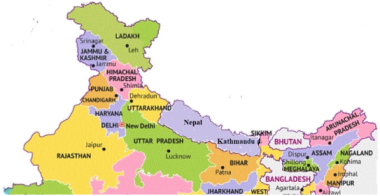How Can Kathmandu Questions And Answers Class 9 Help You Prepare For Exams With Clear Steps
FAQs on NCERT Solutions for Class 9 English Beehive Chapter 8 Kathmandu
1. What are NCERT Solutions for Class 9 English Beehive Chapter 8 – Kathmandu?
NCERT Solutions for Class 9 English Beehive Chapter 8 – Kathmandu provide step-by-step, CBSE-aligned answers to all textbook questions from the chapter "Kathmandu." These solutions help students understand the text, master concepts, and prepare efficiently for the Class 9 English examination as per the 2025–26 syllabus.
2. How do NCERT solutions assist in answering long and short questions from Chapter 8 – Kathmandu?
NCERT solutions guide students on structuring their answers for both short and long questions by offering model solutions, clear explanations of key events, and the proper use of examples from the text. This improves both comprehension and answer-writing skills, ensuring responses align with current CBSE marking schemes.
3. What main differences does the author observe between the Pashupatinath Temple and Boudhanath Stupa in Kathmandu?
The Pashupatinath Temple is portrayed as chaotic, noisy, and crowded, filled with priests, worshippers, monkeys, and the sounds of city life. In contrast, Boudhanath Stupa is described as peaceful, orderly, and soothing, offering a sense of calm amidst the city's bustle, as highlighted in the NCERT Solutions for Class 9 English Chapter 8.
4. Why does the flute seller’s approach in Kathmandu stand out according to the author?
The author notes that the flute seller does not shout to attract customers like other hawkers. Instead, he plays his flute meditatively, distinguishing himself through calmness and an almost spiritual engagement with his craft, making his presence unique in the busy Kathmandu streets.
5. How do the NCERT solutions help students understand the use of figurative language in Chapter 8?
NCERT solutions break down figurative language by explaining metaphors, similes, and imagery found in the chapter. For example, the comparison of the flute bundle to a porcupine’s quills is interpreted to enhance students’ grasp of descriptive and creative expressions within the text.
6. What are some key benefits of using Vedantu’s NCERT Solutions for Class 9 English Chapter 8?
- Accurate, curriculum-mapped answers by experienced educators
- Clarification of difficult words and expressions
- Comprehensive coverage of all textual questions
- Highlighted important and exam-relevant questions
- Quick revision support and summary inclusion
7. What important life lesson does the author express through the line, "To hear any flute is to be drawn into the commonality of all mankind"?
This line from Chapter 8 emphasizes universal harmony. The author suggests that despite differences in flute types worldwide, the music binds humanity together, symbolizing that basic human emotions and experiences are shared across cultures.
8. How do CBSE guidelines influence the format of NCERT Solutions for this chapter?
CBSE guidelines ensure that answers:
- Follow a logical, stepwise format
- Directly address the question’s demand
- Use precise language without unnecessary elaboration
- Reflect the latest exam patterns and marking schemes
9. What vocabulary-building exercises are included in the NCERT Solutions for Kathmandu?
NCERT Solutions provide:
- Word meanings and phrase explanations from the chapter
- Practice exercises for forming nouns from verbs using suffixes (-ion, -tion)
- Activities for correct usage of phrasal verbs and grammatical structures from the text
10. In what way do the NCERT Solutions connect the events of the story to real-life experiences of students?
NCERT Solutions use relatable examples and real-world parallels within their answers, making abstract concepts—like the diversity and unity experienced in Kathmandu—relevant to a student’s own life and experiences, thereby enhancing meaningful learning.
11. How should students approach the grammar exercises in Class 9 English Chapter 8 with the help of NCERT Solutions?
Students should:
- Read the provided solutions for grammatical exercises stepwise
- Understand the context for tense, punctuation, or usage rules included
- Practice similar examples to solidify understanding, as per the provided format in NCERT Solutions
12. What are the most common mistakes students make in Beehive Chapter 8 answers, and how can NCERT Solutions help avoid them?
Common errors include missing main ideas, incomplete answers, or misunderstanding metaphors. NCERT Solutions help students avoid such mistakes by:
- Providing concise and complete sample answers
- Clarifying textual meanings and context
- Emphasizing answer structuring per CBSE standards
13. What steps are recommended in the NCERT Solutions for writing effective answers to character sketch questions from Kathmandu?
Guidelines include:
- Identifying key character traits (e.g., the author’s keen powers of observation)
- Quoting or referencing evidence from the chapter
- Summarizing the character’s impact or role in the narrative concisely
14. How do NCERT Solutions for Class 9 English Chapter 8 address exam-oriented preparation?
They provide:
- Question-wise breakdowns aligned to CBSE patterns
- Explanation of marking scheme expectations
- Tips for time management and structuring answers for maximum score in English exams
15. What should students focus on when revising Chapter 8 using NCERT Solutions before the final exam?
- Review all question types: short, long, and grammar-based
- Understand key themes: diversity, culture, and human connection
- Practice vocabulary and grammar exercises included in the NCERT Solutions
- Memorize the chapter summary and important points as highlighted in the solutions






































